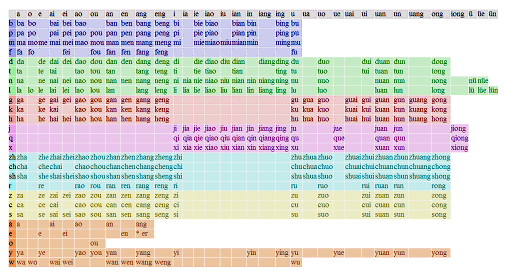Learning Chinese with Pinyin Posted by sasha on Jun 6, 2011 in Uncategorized
For anyone raised on the ABCs and 1-2-3s, learning Chinese can seem to be a daunting task. During my first few weeks in Beijing, I would often stare in disbelief at newspapers, menus, and street signs while thinking to myself, “How am I ever going to understand this language?” Luckily for me, and other equally befuddled foreigners, there is an excellent system in place to assist us in our attempts at learning to speak Chinese (汉语 – hàn yǔ) – pinyin (拼音 – pīn yīn). This is the Romanization of Chinese phonetics, and your gateway to understanding how to speak Chinese. For beginning learners hoping to functionally speak the language, learning to master the 拼音 system should be the first step.
In my case, I moved to China on a whim, having zero experience with the language. I also came to work (工作 – gōng zuò) as an English teacher (英语老师 – yīng yǔ lǎo shī), so I didn’t have the free time to enroll in a university (大学 – dà xué) Chinese program. While I had aspirations to learn how to read (读 – dú) and write (写 – xiě) Chinese, I quickly realized that doing so requires a great deal of work, and is quite difficult to do on your own. I was more concerned with being able to order food (点菜 – diǎn cài), bargain (讲价 – jiǎng jià), and chat (聊天 – liáo tiān) with taxi drivers. Learning to read and pronounce words and sentences in 拼音 helped facilitate this.
Not only will mastery of the 拼音 system set you on your way to being able to converse in Chinese, but it will also help you begin to recognize characters. In order to type in Chinese on a cell phone (手机 – shǒu jī) or computer (电脑 – diàn nǎo), you need to first type in the 拼音 and then choose the correct character. I’ve found that it really helps my reading abilities when I sit down to study (学习 – xué xí) and type out my notes as I go. This really comes in handy when traveling in and around 北京 (Beijing), as the bus/subway maps all have both the 汉字 and the 拼音. Also, you can have fun with friends and practice your skills when you send a text message (发短信 – fā duǎn xìn) to each other in Chinese. Who says studying a complicated foreign language can’t be fun?

Build vocabulary, practice pronunciation, and more with Transparent Language Online. Available anytime, anywhere, on any device.
About the Author: sasha
Sasha is an English teacher, writer, photographer, and videographer from the great state of Michigan. Upon graduating from Michigan State University, he moved to China and spent 5+ years living, working, studying, and traveling there. He also studied Indonesian Language & Culture in Bali for a year. He and his wife run the travel blog Grateful Gypsies, and they're currently trying the digital nomad lifestyle across Latin America.






Comments:
Jack:
I love chinese